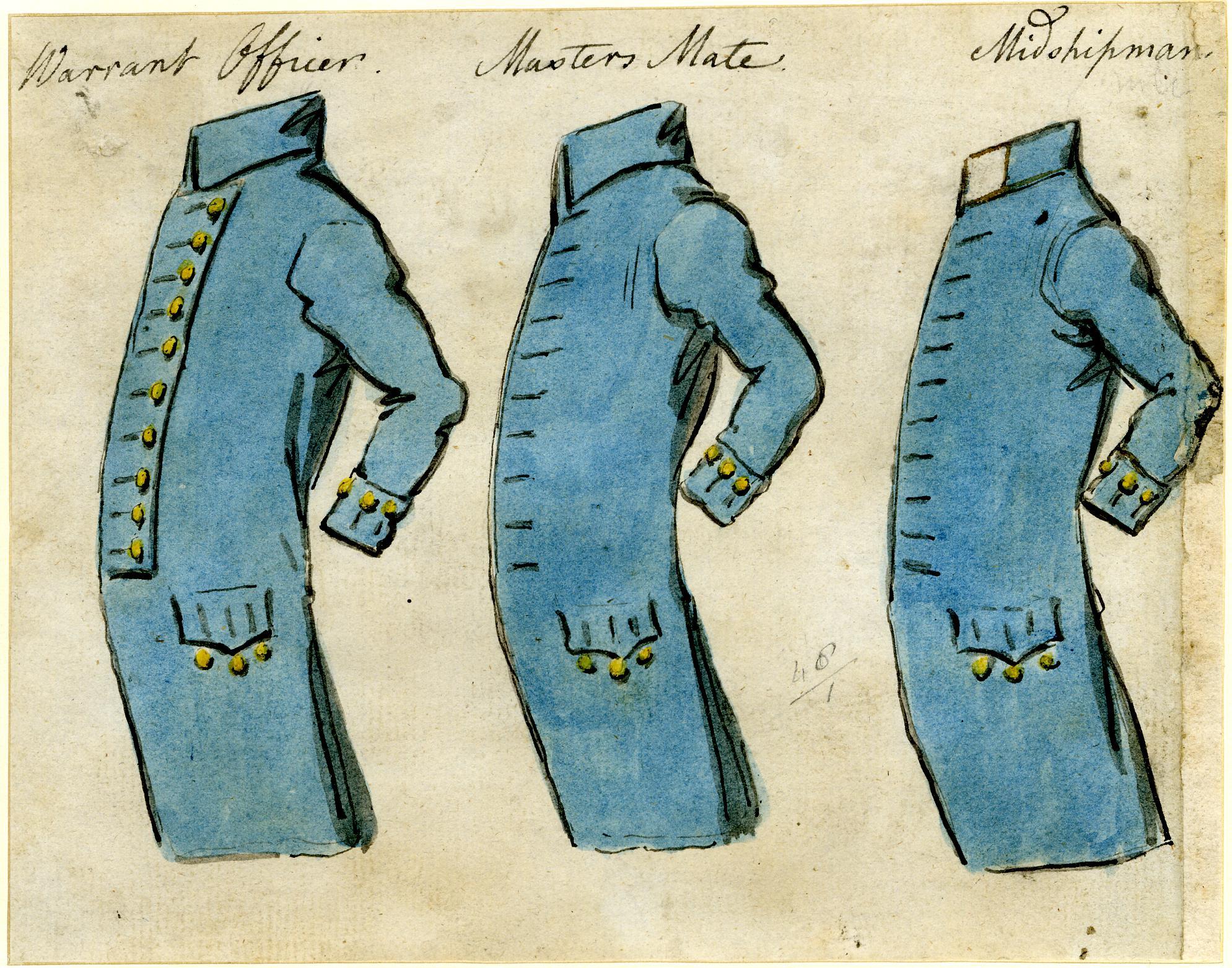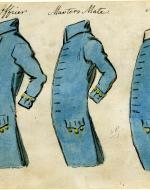Created by Laci Dezern on Wed, 10/02/2024 - 22:43
Description:
Uniforms in England in the latter half of the 18th century were different depending on the rank, branch, and status of the men fighting. The picture above depicts the uniforms of a navel warrant officer, master’s mate, and midshipman respectively. These uniforms were dark blue jackets that opened at the front to prevent fading due to sea spray and long days out in the sun. There was no specific unform until around 1817; however, funding was limited so therefore the unform was both rarely enforced, and Sailors were allowed to add buttons or stripes to mark status and wealth (Historical Surveys of the Evolution of US Navy Uniforms).
In the modern day, warrant officers are “require[d]…to be innovative integrators of emerging technologies, dynamic teachers and mentors, confident warfighters, and developers of specialized teams of Soldier” (Fogg et. al.). In 1775, Britch warrant officers had several titles including “Sailing-Masters, second-masters, and gunners” (Historical Approach to Warrant Officer Classifications). These uniforms had more gold accents and buttons to showcase wealth and status.
Master’s mates were classified as a sub-category of warrant officers in 1775. They were mainly responsible for navigation and were shortened to just “Commander” in 1794. They were lower rank to warrant officers, and therefore did not have the wealth to have as many gold buttons and stipes. Yet, they still played an important role in the ranking system of the British Royal Navy.
Midshipmen were lower ranked than the previous two officers and were oftentimes classified as petty warrants and petty officers. These officers were at best classified above non-commissioned officers but were not above senior officers. In the modern day, this position is officially titled as “Junior commissioned officers” (Www.Canadiansoldiers.Com). As a result, the uniforms have less buttons and stripes as the other officers. The neck is also without a full collar the other two uniforms have, symbolizing the lower rank these men held.
However, there were differences in regalia depending on the militia. These uniforms were from the Napoleonic wars that took place around the late 18th and early 19th century. The uniforms pictured are specifically from the British Royal Navy. The most recognized uniform from this time period, specifically most known from the American Revolutionary War, was bright red with gold accents. They were flashy, loud, and overall unattractive outside of the battlefield. This is a point that Jane Austen mocks in her Pride and Prejudice, especially since they do not often change out of this outfit and therefore are noticeable to the common people. Austen alludes to the fact that “the British military that, during the Regency era, saw less action than revelry;” (Amoruso). She then proceeds to make the women and girls indicate “the danger officers pose to young women, while refuting Fordyce’s claims that ostentatious colors like the red of their uniform coats will appear unattractive” (Amoruso). Unforms from the British Militia varied depending on the time period, rank, status, and branch each man was in.
Works Cited
“All You Wanted to Know about 18th Century Royal Navy.” Google Books, Google, books.google.com/books?id=_sKZ3rZK4dQC&q=master%2Band%2Bcommander%2BRoyal%2BNavy%2Bafter%2B1794&pg=PA30#v=onepage&q=uniform&f=false. Accessed 7 Oct. 2024.
“All You Wanted to Know about 18th Century Royal Navy.” Google Books, Google, books.google.com/books?id=_sKZ3rZK4dQC&q=master%2Band%2Bcommander%2BRoyal%2BNavy%2Bafter%2B1794&pg=PA30#v=snippet&q=master%20and%20commander%20Royal%20Navy%20after%201794&f=false. Accessed 7 Oct. 2024.
Amoruso, Malika. “‘Not Every Single Man is Looking for a Wife’: Austen, Fordyce, and Fire Island.” Jane Austen Society of North America, jasna.org/publications-2/persuasions-online/volume-44-no-1/amoruso/. Accessed 7 Oct. 2024.
DeForest, Mary. Jane Austen and the Anti-Heroic Tradition, jasna.org/persuasions/printed/number10/deforest.htm. Accessed 8 Oct. 2024.
Fogg, Rodney, and Jonathan Yerby. “Technical Expert, Not Executive: A Sustainment Warrant Officer’s Role.” Army Sustainment, vol. 52, no. 2, Apr. 2020, pp. 20–23. EBSCOhost, search.ebscohost.com/login.aspx?direct=true&db=aph&AN=142959808&site=ehost-live&scope=site.
Gillray, James. The uniforms of a Warrant Officer, Master’s Mate and Midshipman. 1772.
Historical Approach to Warrant Officer Classifications, www.history.navy.mil/research/library/online-reading-room/title-list-alp.... Accessed 7 Oct. 2024.
Historical Surveys of the Evolution of US Navy Uniforms, www.history.navy.mil/research/library/online-reading-room/title-list-alp.... Accessed 7 Oct. 2024.
Www.Canadiansoldiers.Com, www.canadiansoldiers.com/ranks/major.htm. Accessed 7 Oct. 2024.
Copyright:
Associated Place(s)
Part of Group:
Featured in Exhibit:
Artist:
- James Gillray


